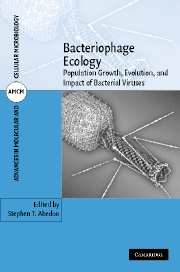Book contents
- Frontmatter
- Contents
- About the cover
- List of contributors
- Foreword by Bruce R. Levin
- Preface
- 1 Phages, ecology, evolution
- Part I Phage ecology
- Part II Phage evolutionary biology
- Part III Phage ecology in environments
- 10 Aquatic phage ecology
- 11 Phage ecology of terrestrial environments
- 12 Phages, bacteria, and food
- 13 Interaction of bacteriophages with animals
- 14 Phage ecology of bacterial pathogenesis
- Part IV Modeling phage ecology
- Index
- Plate section
11 - Phage ecology of terrestrial environments
from Part III - Phage ecology in environments
Published online by Cambridge University Press: 29 September 2009
- Frontmatter
- Contents
- About the cover
- List of contributors
- Foreword by Bruce R. Levin
- Preface
- 1 Phages, ecology, evolution
- Part I Phage ecology
- Part II Phage evolutionary biology
- Part III Phage ecology in environments
- 10 Aquatic phage ecology
- 11 Phage ecology of terrestrial environments
- 12 Phages, bacteria, and food
- 13 Interaction of bacteriophages with animals
- 14 Phage ecology of bacterial pathogenesis
- Part IV Modeling phage ecology
- Index
- Plate section
Summary
INTRODUCTION
Terrestrial environments differ from aquatic environments in terms of the extent and persistence of inundation, with the terrestrial world, of course, drier than the aquatic one. Despite this basic difference between aquatic and terrestrial environments, the survival and reproductive problems faced by bacteriophages in the terrestrial world, such as within soils, can be similar to those faced in aquatic habitats or, for that matter, can be similar to those faced in or on plants or animals. Indeed, to the extent that bacterial hosts grow in biofilms, it matters little — periodic desiccation aside — whether we think of these bacteria as inhabiting rivers, puddles, sediment, soil, or, alternatively, other organisms. Therefore, although this chapter concentrates on soil as the environment, we will review studies performed in various non-terrestrial environments, to the extent that they illuminate our understanding of phage ecology in the terrestrial world. We will briefly consider phage and bacterial host life histories as they are integrally associated, drawing themes together using relevant information derived from the study of associations and interactions between phages and prokaryotes in other environments to see what is consistent, possible, or improbable. In addition, we review common themes associated with phage-mediated horizontal (also described as lateral) gene transfer between bacteria (transduction) as it occurs in the wild.
- Type
- Chapter
- Information
- Bacteriophage EcologyPopulation Growth, Evolution, and Impact of Bacterial Viruses, pp. 281 - 301Publisher: Cambridge University PressPrint publication year: 2008
- 1
- Cited by

